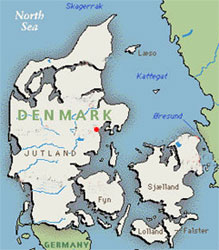Aarhus (Århus), Denmark
 |
|
Aarhus (Århus) is the second largest and one of the oldest cities in Denmark. Aarhus is a vibrant city due in large part to the huge amount of students who attend University in the city. The city has a fine downtown centre with many fine walking streets, decent shopping, many quality museums, and many excellent restaurants. The population of the city is over 300,000.
The locals from time to time refer to Aarhus as being ‘the smallest metropolis in the world’, because the city has a large harbour, a university, a sizeable immigrant population, and many large companies have their main European business headquarters in the City. Visitors to Aarhus can also experience a multi-cultural bazaar called Bazaar West (Bazar Vest) in the Brabrand suburb.
Aarhus is also the home of a variety of festivals such as Aarhus Party Week (Århus Festuge). Aarhus party week is held in the first week of September every year, and the festival offers a wide range of cultural and art experiences.
History:
 The original name of the city is ‘Aros’, which means, “The mouth of the stream”. The original name refers to the location of the city. In the 9th century a mound was built in a curved shape around the city as a means of protection. There is a small section of the mound, and a variety of findings from the Viking Age on display in the basement under the Nordea bank on the street ‘Sankt Clemens Torv’.
The original name of the city is ‘Aros’, which means, “The mouth of the stream”. The original name refers to the location of the city. In the 9th century a mound was built in a curved shape around the city as a means of protection. There is a small section of the mound, and a variety of findings from the Viking Age on display in the basement under the Nordea bank on the street ‘Sankt Clemens Torv’.
The exact age of the city is somewhat disputed by historians. What is known is that in 951 Aarhus was named bishopric. However, Aarhus most certainly was a town prior to that date. Archaeological findings show that a town existed in the early Viking Ages at least 1300 years ago. The city is believed to be older than 770 AD which would make Aarhus the oldest big city in Scandinavia.
The convenient location of Aarhus on the Jutland (Jylland) region of Denmark meant that trade would inevitably flourish with Germany, the lands around the Baltic Sea, and of course Denmark itself. It is important to remember that Denmark is made up of many islands, and sea trade to and from these islands had an enormous impact on the development of the town. In fact sea trade is still of vital importance to Aarhus today.
Despite the importance of the city Aarhus expanded very little outwards, and the population remained quite low until the late 19th century. It was Aalborg that was the largest city in Jutland until the 1920s. The growth and expansion of Aarhus took place quite late compared to other European cities. However, Aarhus’s growth and expansion took place for the very same reasons as the other European cities. During the industrial revolution rural populations generally migrated into urban areas in search of work. Another reason is that with the coming of mass industrialisation it became more important for traders to be as close to the main trade routes as possible. The harbour in Aarhus meant that the city became a natural target for growth due to industrialisation.
As expected the Harbour was a major factor in the development of the city. Archaeological evidence shows that the harbour was in use long before Aarhus could ever be considered a town. During the Viking Age the harbour was of vital importance to trade and commerce. Through the Middle Ages the harbour grew in size and importance for the whole region. Traders from all over Northern Europe would use the harbour to deliver their goods. The most important trade took place with the city of Copenhagen (København). Aarhus was a natural choice for traders because the harbour could accommodate the largest of ships from the period.
In the 18th century the demand for corn for the export marked increased a greatly. The economic factor helped created lucrative conditions for the farmers and the grocers throughout the whole Aarhus area. Since farmers were doing so well financially this was also a very lucrative time for craftsmen in the city who supplied the farmers with tools and machines.
The harbour is still being expanded today, and it is the home of a huge number of workplaces for the locals. On the southern side of the harbour is the lively Marselisborg Harbour (Marselisborg Havn), which has many restaurants and performance stages. In the summertime there is hardly a week which goes by when there isn’t some form performance taking place on one of the stages. Along the northern part of the harbour there is a nice walking and bike path. Along the walking path there are great sunbathing, and swimming opportunities.
Aarhus - Things to See and Do (Part 1)
Aarhus - Tourist Sites (Part 2)
Aarhus - More Tourist Attractions (Part 3)
LastUpdate: 2019-06-26 19:11:02
